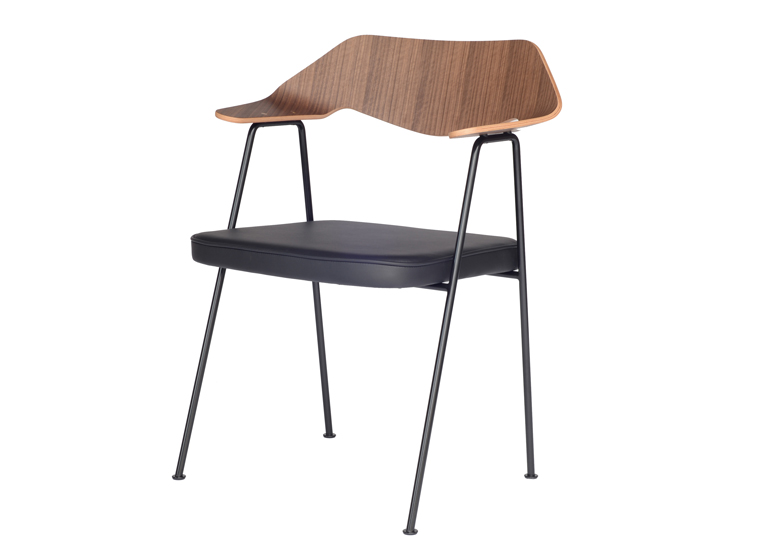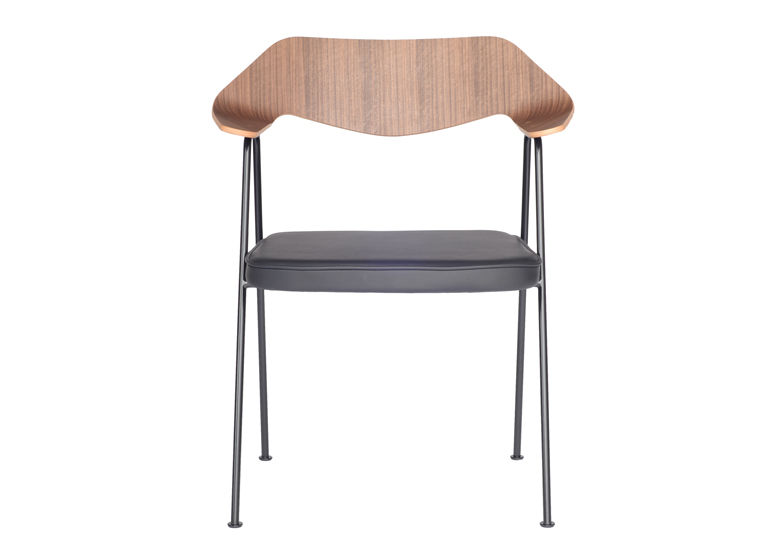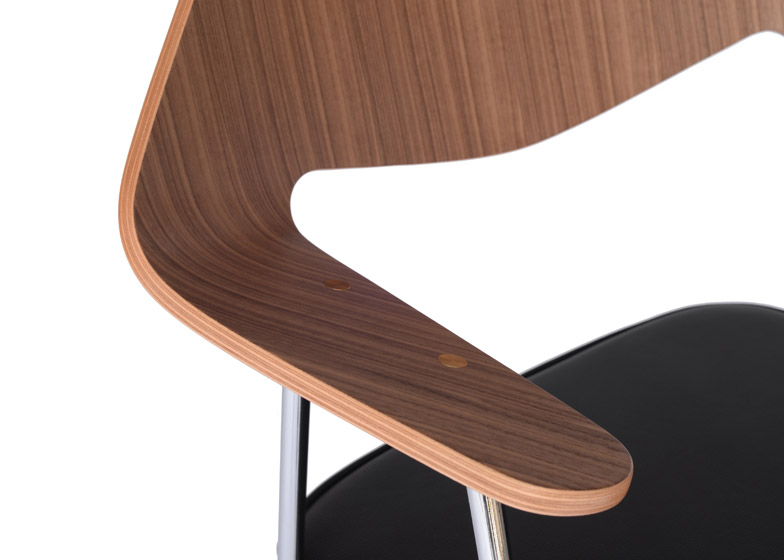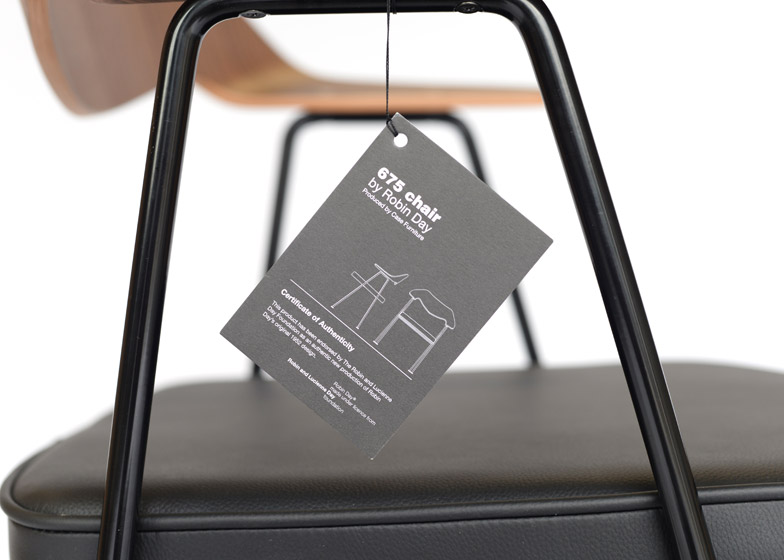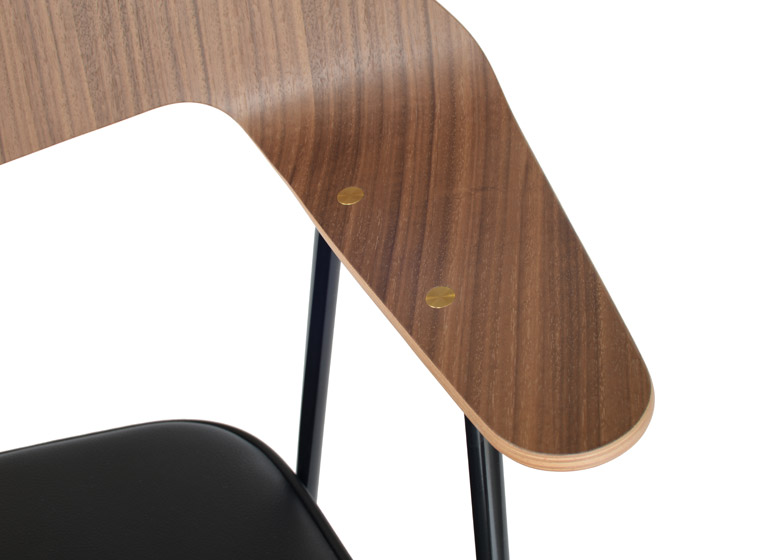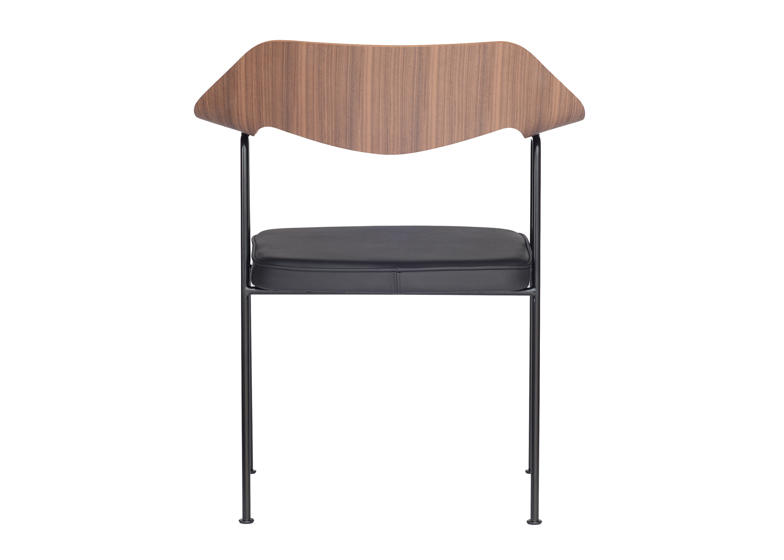London Design Festival 2014: the daughter of British designers Robin and Lucienne Day talks to Dezeen about preserving her parents' legacy and the launch of a new version of her father's much replicated 675 Chair (+ interview + slideshow).
Robin and Lucienne Day were among the leading designers of the 20th century – Robin specialising in furniture and Lucienne in textiles. Following a talk on managing her parents' design legacy with Paul Newman, founder of Case Furniture and design historian Charlotte Fiell at the V&A museum, Paula Day spoke to Dezeen about protecting the Day estate.
"Soon after both my parents' deaths I discovered that their names were being used to sell products described as Robin Day or Lucienne Day designs by various companies, which had not set up any kind of consultation or agreement either with my parents or with their estate," Paula Day told Dezeen.
"I just wasn't prepared to allow their names and works to be misused and realised actually that I was the only person who could take that on."
Paula Day set up the Robin and Lucienne Day Foundation in 2012. The Foundation recently trademarked her parents' names, an action which makes the unlicensed use of Robin Day's name to sell furniture, and of Lucienne Day's name to sell products across ten categories, an infringement of the Foundation's trademarks.
"In most cases, the products are crude, poor quality imitations of designs that my parents had spent many months working to perfect," Day told Dezeen.
Working closely with Paula Day, Case Furniture launched a new production of the 675 Chair that aims to honour Robin Day's original 1952 design at this year's 100% Design trade fair.
The company has produced a version of the 675 Chair by Robin Day for four years prior to the launch. Inspired by the dimensions of the Habitat production of the same chair it had "very different radius and angles," according to Duncan Bull, product development designer at Case.
"What was surprising was how much the chair had changed since its original production in 1952," added Case Furniture founder Paul Newman. "The frame was a different gauge, dimensionally different and the plywood component had a very different profile."
With no technical drawings of the original design available, Case sourced an original 1952 675 Chair and sent it to the company's factory in Germany for 3D scanning. An aluminium press tool used to manufacture the chair was produced from the scan.
"The goal for the Foundation and ourselves was to navigate through these various constructional issues and to create a quality chair that remained true to the original design both visually and structurally," Newman told Dezeen.
As in the original design, the chair features a curved plywood back and arm rests, chrome plated steel frame with circular feet and an upholstered seat pad. Case has produced the chair with a walnut ply back coupled with a black leather seat.
The smooth-headed brass pins that fix the wooden back to the steel frame are the only discernible difference in the two designs. According to Duncan Bull, Product Development Designer at Case, the decision to use brass pins came when the company noticed the heads of the machine-headed screws used in the original design had become shredded due to tightening over the years.
Paula Day finished her V&A talk by offering some advice to designers who wished to protect their work. "Have a good lawyer, because if you haven't you're going to need a damned good daughter."
Read an edited version of the transcript from the interview with Paula Day below:
Jessica Mairs: How does it feel to have such a legacy to protect?
Paula Day: I never expected it, I gradually realised I had absolutely huge responsibility and I just felt that it was actually my job. It wasn't what I wanted to spend my life [doing], it certainly wasn't what my parents expected of me and they didn't realise quite, well they didn’t realise at all what would happen to their work.
Partly, there's been so much more interest – there's been accelerating interest in their work. In their last years it was only beginning so it's enormously increased since they died. They certainly wouldn't wish it on me, but I just wasn't prepared to allow their names and works to be misused and realised actually that I was the only person who could take that on. I get lots of advice and lots of help, but ultimately I'm someone who can really just stand and represent them.
Jessica Mairs: Has there been much copying of your parent's designs?
Paula Day: Soon after both my parents' deaths I discovered that their names were being used to sell products described as Robin Day or Lucienne Day designs by various companies which had not set up any kind of consultation or agreement either with my parents or with their estate.
Jessica Mairs: How damaging are inauthentic designs to their reputation?
Paula Day: Products described as Robin or Lucienne Day designs, which have been developed without any kind of consultation with the designers or their estate, are unlikely to accurately represent the designs. Yet the public will assume that they are authentic, and will therefore be misled as to what my parents actually did. In most cases, the products are crude, poor quality imitations of designs, which my parents had spent many months working to perfect. Obviously this damages their reputation.
Jessica Mairs: How is the foundation safeguarding their designs?
Paula Day: Unfortunately UK copyright law has only covered designs (as opposed, say, to literature or fine art) for 25 years from the date of the design. The law changed in April 2014 but it has yet to be seen how effective this will be. However, the foundation has been able to register trademarks in the names Robin Day and Lucienne Day. Any unlicensed use of my father's name to sell furniture, and of my mother's name to sell products in ten categories, is an infringement of the foundation's trademarks. This is very useful because the designs in themselves would probably have less commercial appeal if marketed without any reference to the names Robin Day and Lucienne Day.
Our website includes a "licensees" page that lists the companies currently marketing products which have been licensed and endorsed by the Foundation. Products currently marketed by any other company as Robin or Lucienne Day designs should not be assumed accurately to represent the original designs.
Jessica Mairs: Can you tell me about reissuing of your parents' designs, and the 675 Chair with Case Furniture?
Paula Day: Since I set up the foundation in 2012 there have been two, I tend to call them new productions because it is a whole new process. Reissue sounds to me a bit like a very simple thing. A new production obviously involves all sorts of technical challenges to the companies involved. So this year, we worked, or we’ve been working, with John Lewis who have brought out two Lucienne Day ranges of her 1954 dress fabrics and her mid-1970s furnishing fabrics which she did for Cavendish Textiles, which is a John Lewis company. So John Lewis have brought out their own Lucienne Day designs really, in collaboration with us. And then Case Furniture brought out a new authentic version of my father's 675 Chair.
Jessica Mairs: Are there differences between the originals and the Case designs?
Paula Day: Certainly there are, because there are new production methods. It's a complex area that I've had to start learning around really, all sorts of complex philosophical issues among others. But it seems to be that if it's furniture, the form and structure of the chair should be identical.
There will be new materials, for example there are much better kinds of upholstery available. The actual cushion will be different, for example. But the actual visual structure, if you like the sculptural look of the chair, should be the same in my view. We’re working on our endorsement policy but that's the way it's going.
Jessica Mairs: Can you tell me about the changes to the seat upholstery?
Paula Day: I think the upholstery fabrics we shouldn't be rigid about. I don't think that they're essential to the design, personally. We're talking about furniture here, obviously if we come to my mother's work I think the kind of fabric, the kind of base cloth, is very much part of the design. The colourways are absolutely integral, you can't take a Lucienne Day design and change the colourway because not only is it obviously the wrong colour, but it can distort the design because the colourway creates the impact, the energy of the design.

